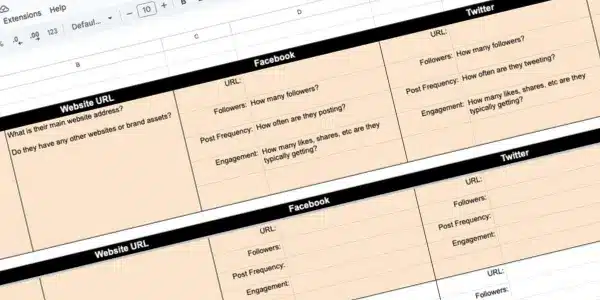Understanding your competitors is just as critical as understanding your customers. Performing a competitor analysis is often the first recommendation that we make before designing a marketing plan for our clients.
Whether you’re a solo entrepreneur, a small business owner, or leading a growing team, competitor analysis is a powerful tool for identifying market gaps, refining your marketing strategies, and ultimately gaining a competitive advantage.
You’re the coach of your business. Would you want to go into a game not knowing what your team is up against? You wouldn’t. No good leader leaves their team unprepared. Neither should you.
Identifying the Right Competitors

Before diving into analysis, the first step is identifying who your actual competitors are. These fall into two main categories: direct and indirect competitors. Direct competitors are those offering similar products or services to the same target audience. Indirect competitors, on the other hand, solve the same customer problem but with a different type of solution.
Sometimes clients don’t really know who they are competing against. Most companies will know who their direct competitors are in their market. it’s often pretty obvious. However, that may not be who you are competing against online. You need to know who is showing up when you search for businesses like yours. If you want to rank in search, you need know why they are showing up.
To find your competitors, start with a simple online search using keywords that your potential customers would likely type. Review local directories, explore relevant industry forums, browse review websites like Yelp or BBB, and observe which businesses appear frequently in conversations or search results within your niche. This initial discovery phase lays the foundation for everything that follows.
Analyzing Competitor Products and Services

Once you’ve identified your competitors, the next step is to evaluate what they’re selling and how they are presenting their offerings. Look at product quality, pricing, packaging, and any value-added features or services. Examine how they highlight the benefits of their products and what makes their offer compelling from the customer’s perspective.
Customer reviews can be particularly revealing. They help uncover what buyers appreciate and what frustrates them. By digging into this feedback, you can begin to identify opportunities to position your product or service as a more effective or appealing alternative.
Understanding Their Marketing Strategy

A key part of competitor analysis is gaining insights into how your competitors attract and engage their audience. Their website and content are great starting points. Review their blog, landing pages, and calls to action. Evaluate the frequency and consistency of content updates. Are they using videos, case studies, or downloadable guides? How easy is it to navigate their website, and is it mobile-friendly?
Beyond the website, examine their presence across digital marketing channels. Sign up for their email newsletters to observe the cadence, tone, and value of their email campaigns. Follow them on social media and pay attention to what platforms they use, how they engage their audience, and what kind of content garners the most interaction.
Use SEO tools to uncover the keywords they rank for and the backlinks they’ve earned. What are they ranking for that you are not? What keywords are getting them the most traffic and how can you find related keywords that your business can take advantage of? This information is critical, especially if you are rebranding or refreshing online assets like websites and social media accounts.
Evaluating Brand Positioning and Messaging

Brand messaging plays a vital role in how businesses differentiate themselves. Review how your competitors present their mission, core values, and value proposition. Take note of their tone of voice, imagery, and overall style. Are they positioned as friendly and approachable or authoritative and professional?
Understanding their positioning helps you clarify your own. Consider how your brand compares. Where can you be clearer, more personable, or convey stronger expertise? Strong brand messaging is what helps you connect with your audience on a deeper level and stand out in a crowded market.
Assessing the Customer Experience

To fully understand how your competitors operate, it helps to experience their customer journey firsthand. Navigate through their website, subscribe to their email list, request a quote, or even go through a mock purchase process. Evaluate how intuitive and seamless the experience is from start to finish.
Look for strengths and weaknesses in areas such as website speed, checkout flow, customer support response time, and follow-up communication. The ease or friction within their process offers valuable lessons and helps you create a better experience for your own customers.
Customer experience is becoming more and more important in crowded markets. People don’t have the patience for a bad experience. Attention spans are short and they’ll find someone else.
Benchmarking Key Performance Metrics
To take your analysis a step further, gather data on how well your competitors are performing online. Tools like Semrush and SpyFu allow you to estimate website traffic, traffic sources, keyword rankings, and advertising strategies. Review their content performance to identify which blog posts or videos generate the most engagement.
On social media, assess follower counts, post engagement, and any patterns in the types of content they publish. These benchmarks provide context for your own performance and highlight areas where you can improve or differentiate more effectively.
Applying the Insights to Your Business
The value of competitor analysis is in the actionable insights you gather. Once you’ve gathered these insights, use them to refine your products, improve your messaging, or enhance your marketing strategies. Identify what competitors are doing well and determine how you can do it better—or differently. Address customer pain points that competitors overlook. Elevate your brand voice, improve your website experience, or create content that fills gaps in the current market.
Competitor analysis should not be about imitation. It’s about finding your unique space and delivering value in a way that resonates more deeply with your ideal audience.
Creating a Competitor Analysis Matrix

Competitor analysis is not a one-time task—it’s an ongoing discipline that keeps your business sharp and responsive. By consistently monitoring your competition, you gain clarity on what sets your brand apart and how to position yourself for long-term growth. Whether you’re launching a new product or adjusting your marketing strategy, competitor analysis empowers you to move with purpose and confidence.
Understanding your competition isn’t just about staying afloat—it’s about staying ahead. With the right insights and a strategic mindset, you can strengthen your business, serve your audience better, and grow with intention in any market.
Need help with with your marketing strategy? Click here to schedule a FREE Consutation.
I hope you found value with today’s post.
If you did, please leave a comment and share with your fellow digital marketers.
To Your Success!

Steve Stark
steve@starkwebdesign.com
262-378-0234
Follow us on Facebook



